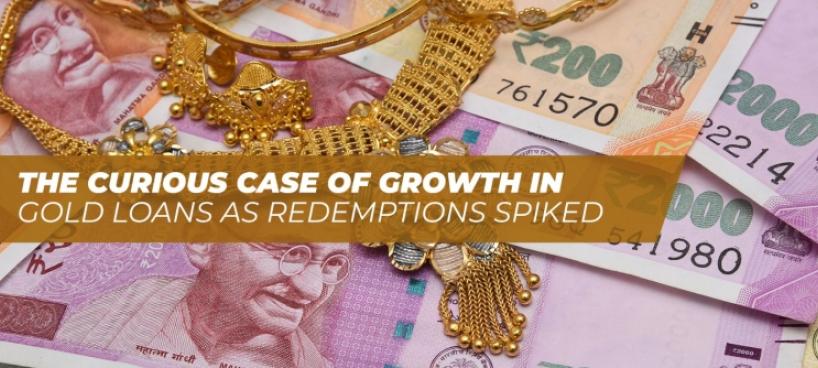
By V.P. Nandakumar
Soon after the first phase of the lockdown was over and NBFCs were allowed to resume operations at their branches, there was much interest in the financial media about how gold loans would hold up in the current scenario where economic activity is at a low and GDP growth is heading into negative territory.
The expectation was that the demand for gold loans would surge in keeping with the wider observation that most lenders in India have become risk averse and were focused on reducing their exposure to vulnerable customers. This is, of course, the direct outcome of the nationwide lockdown which effectively shut down the economy and which was aggravated by the RBI’s moratorium package, which led to a flight to safety among banks and NBFCs alike. Consequently, small borrowers and businesses were being starved for want of debt capital, be it to restart operations, or pay wages. Their working capital cycle was stretched to breaking points.
Amidst this widespread risk aversion, only the gold lenders stood firm and kept their doors open for everyone. Even during the lockdown, when most lenders had stopped lending, gold loan companies were disbursing fresh loans through digital modes. Safety, or worries about likely defaults, is not an issue for the gold loan companies as the gold collateral (i.e. the jewellery pledged by borrowers) is held in the custody of the lenders and can be easily liquidated in the event of default.
After the lockdown restrictions were relaxed in mid-April, NBFCs were able to reopen most of their branches, giving customers the opportunity to borrow afresh or close their existing loans and take the jewellery back. With other lenders turning shy and with gold prices climbing to historic highs, the expectation was that gold loans would take off, if not from new borrowers, then at least from existing borrowers who could choose to renew their pledges at the higher loan to value (LTV) ratio prevailing now.
However, over the next one and half months till the end of May, most gold financiers saw a decline in their holdings of gold collateral in the range of 2 to 5 percent from March levels, as there was a rush of people looking to settle their loans and take back the jewellery. At the same time, the overall gold loan portfolio showed an increase, as the redemptions were more than offset by borrowers availing fresh loans at higher LTV (where the loan amount increases without needing more gold for pledge). And this brings us to something of a puzzle, why there should be a decline in collateral tonnage, even as demand for gold loans is high?
In trying to answer this question, let’s try and get a sense of who the gold loan customers typically are and the reasons why they borrow against their family jewellery.
To begin with, these customers are overwhelmingly those who do not have ready access to credit from the institutional lenders. Afterall, most of them don’t earn salaries, and they are unlikely to have proof of a regular income. Such would be the case with small time vendors and shopkeepers, the self-employed tradesmen etc. Secondly, their requirement of money would be urgent although they need the money only for a short period, say, to offset a temporary mismatch in cash flows. Some may borrow for just a few days or a few weeks. In fact, there are vendors who may borrow the money in the morning to purchase goods, sell them over the course of the day, then repay or close their loan by end of day to take back the jewellery the same day. The availability of such a unique short-term loan ensures their livelihood.
At the same time, there is always a choice between selling the jewellery as scrap or borrowing against it. Which of these options gets picked would depend on the proposed use to which the money is to be put to. If it is meant for an income generating activity, chances are they would prefer to borrow.
However, when faced with a severe downturn in business where there is no sight of a revival anytime soon, their stress levels go up and they may resort to the sale of their gold jewellery. This trend becomes stronger at times of high gold prices, such as now. The lockdown would have disrupted their daily routine of borrowing, trading and repayment and dented their confidence in their own ability to generate a profit good enough to repay a loan. At this point, they may prefer to sell their jewellery to raise funds because a loan would fetch them only 75 percent of the gold value, whereas a scrap sale would likely fetch them full value for the bullion content of the jewellery (though not for the making charges or the taxes paid). In fact, we have been hearing reports about customers coming to the branch accompanied by scrap dealers who fund the repayment and then acquire the jewellery from the borrower. This is one side of the picture.
On the other side, with gold prices in India ruling at historic highs, a customer today stands to get a higher loan amount that what he would have likely paid to acquire the jewellery. As all the other sources of loans run dry, a gold loan becomes the natural fall-back option. It gives them access to the capital needed to re-start their businesses, leading to growth in the overall asset size of the gold financiers. These two aspects, seemingly contradictory, may now be seen as two sides of the same coin.
Published in Unique Times Magazine, June 2020
(V.P. Nandakumar is MD & CEO of Manappuram Finance Ltd. Views are personal.)






